
What are x-coordinate and y-coordinate called?
Answer
465.3k+ views
Hint: We will describe what we understand by knowing the x-coordinate and the y-coordinate. We will look at the x-axis and the y-axis, and the plane formed by these two axes. We will study the four quadrants formed by these axes by seeing the change in the x-coordinate and the y-coordinate in every quadrant.
Complete step by step answer:
The x-coordinate gives us the distance of a point from the vertical axis, that is, the y-axis. The x-coordinate is also called abscissa. The y-coordinate tells us the distance of a point from the horizontal axis, that is, the x-axis. The y-coordinate is also called the ordinate. The two axes, x-axis and y-axis form the xy-plane. We can see it in the figure below,

While denoting the location of a point on the xy-plane, we use the following format: $\left( x,y \right)$, here $x$ is the x-coordinate and $y$ is the y-coordinate.
In the figure above, we can see that the xy-plane is divided into four quadrants. The first quadrant consists of all positive x-coordinates and all positive y-coordinates. The second quadrant has negative x-coordinates and positive y-coordinates. In the third quadrant all the x-coordinates as well as all the y-coordinates are negative. The fourth quadrant has positive x-coordinates and negative y-coordinates.
Note: The y-axis that lies above the x-axis is called as the positive y-axis and the y-axis that lies below the x-axis is called as the negative axis. This is intuitive, since the positive y-axis has all positive y-coordinates and the negative y-axis has all the negative y-coordinates. Similarly, The x-axis to the right side of the y-axis is called as the positive x-axis and to the left of the y-axis is called as the negative x-axis. For convenience, we can denote the positive axes as x-axis and y-axis and the negative axes by $\text{x }\!\!'\!\!\text{ }$-axis and $\text{y }\!\!'\!\!\text{ }$-axis.
Complete step by step answer:
The x-coordinate gives us the distance of a point from the vertical axis, that is, the y-axis. The x-coordinate is also called abscissa. The y-coordinate tells us the distance of a point from the horizontal axis, that is, the x-axis. The y-coordinate is also called the ordinate. The two axes, x-axis and y-axis form the xy-plane. We can see it in the figure below,

While denoting the location of a point on the xy-plane, we use the following format: $\left( x,y \right)$, here $x$ is the x-coordinate and $y$ is the y-coordinate.
In the figure above, we can see that the xy-plane is divided into four quadrants. The first quadrant consists of all positive x-coordinates and all positive y-coordinates. The second quadrant has negative x-coordinates and positive y-coordinates. In the third quadrant all the x-coordinates as well as all the y-coordinates are negative. The fourth quadrant has positive x-coordinates and negative y-coordinates.
Note: The y-axis that lies above the x-axis is called as the positive y-axis and the y-axis that lies below the x-axis is called as the negative axis. This is intuitive, since the positive y-axis has all positive y-coordinates and the negative y-axis has all the negative y-coordinates. Similarly, The x-axis to the right side of the y-axis is called as the positive x-axis and to the left of the y-axis is called as the negative x-axis. For convenience, we can denote the positive axes as x-axis and y-axis and the negative axes by $\text{x }\!\!'\!\!\text{ }$-axis and $\text{y }\!\!'\!\!\text{ }$-axis.
Recently Updated Pages
How to find how many moles are in an ion I am given class 11 chemistry CBSE

Class 11 Question and Answer - Your Ultimate Solutions Guide

Identify how many lines of symmetry drawn are there class 8 maths CBSE

State true or false If two lines intersect and if one class 8 maths CBSE

Tina had 20m 5cm long cloth She cuts 4m 50cm lengt-class-8-maths-CBSE

Which sentence is punctuated correctly A Always ask class 8 english CBSE

Trending doubts
The reservoir of dam is called Govind Sagar A Jayakwadi class 11 social science CBSE

What problem did Carter face when he reached the mummy class 11 english CBSE

What organs are located on the left side of your body class 11 biology CBSE

Proton was discovered by A Thomson B Rutherford C Chadwick class 11 chemistry CBSE

Petromyzon belongs to class A Osteichthyes B Chondrichthyes class 11 biology CBSE

Comparative account of the alimentary canal and digestive class 11 biology CBSE




